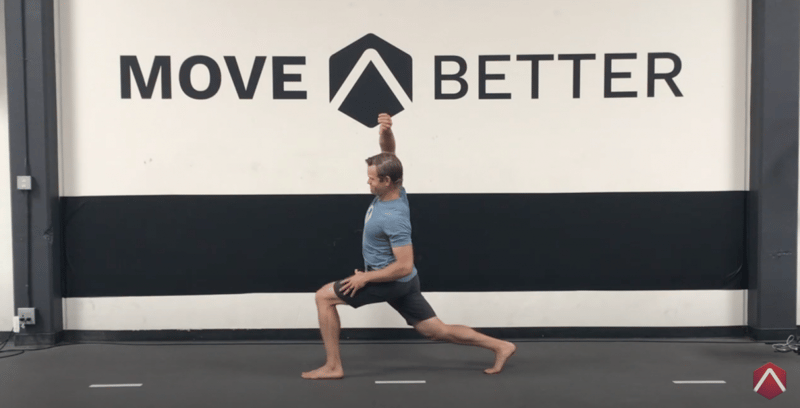
The reverse lunge is a great movement to use in the warmup, particularly it stretches out that front side of the body.
If we look from an overhead view, we should be covering that front foot with the thigh. So if we’re looking down, we shouldn’t be able to see that front foot. What we don’t want is we don’t want that foot or that thigh misaligned. We don’t want that thigh and knee collapsing inward during the movement. The other key piece is to think about bracing hard in the abdominals, almost like you’re getting punched in the gut and that’s going to prevent the back from arching. Another critical piece to avoid the back from arching is not looking up with the eyes. All of this allows a deeper stretch of what’s called the deep frontline or muscles like the psoas in particular, which is a very strong hip flexor but also has some lateral rotation.
Recommendation is to perform this exercise every day for three reps each.
You don’t want to be feeling it in the lower back or the backside of the body, or even in the lower leg, focusing on that psoas. Often, we need this because we sit most of the day and that sitting causes a tight hip flexor and ultimately low back pain because that’s psoas restricts the hip joint movement, which then pulls on the vertebrae of the low back. What ends up happening to the pelvis is that it tilts that pelvis forward and creates that low back arch to that anterior pelvic tilt, which shortens the muscles. And that shortened muscles makes this more likely for muscle strains, particularly when we run like a hamstring.
Because a short muscle plus the actual stretch of striding when you run starts to put that muscle at risk for tearing, and so the best way to do this movement is every day, usually about three reps, because each rep takes about five seconds or more if done correctly. As you progress, start to add in a little bit of a lateral rotation to the movement to stretch that psoas further. Best to use with athletes that have a low drive on a jump, on the jump scan. So athletes with a low drive on the Sparta scan can benefit from this movement because if there’s a longer psoas, there’s also a longer ability to sustain force production in movements such as a jump.
We don’t want that thigh and knee collapsing inward during the movement.
We want to think about bracing hard in the abdominals to help prevent the back from arching. Also, making sure we aren’t looking up with our eyes.
The best way to do this type of movement is every day for three reps each. Generally, individuals that have a lower drive score are the ones that could benefit most from this type of movement. When progressing, start to add in a little bit of a lateral rotation to the movement to stretch that psoas further.
Regardless of the training day, utilizing the reverse Lunge is a must-add to your warmup routine.